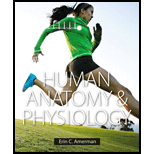
Human Anatomy & Physiology
1st Edition
ISBN: 9780805382952
Author: Erin C. Amerman
Publisher: PEARSON
expand_more
expand_more
format_list_bulleted
Question
Chapter 27.5, Problem 2QC
Summary Introduction
To review:
The changes in women’s nutritional requirements during pregnancy.
Introduction:
The 9months of pregnancy brings several hormonal, anatomical, and physiological changes in the mother. These changes affect several organ systems of the body such as the reproductive system,
Expert Solution & Answer
Want to see the full answer?
Check out a sample textbook solution
Students have asked these similar questions
students in a science class investiged the conditions under which corn seeds would germinate most successfully. BAsed on the results which of these factors appears most important for successful corn seed germination.
I want to write the given physician orders in the kardex form
Amino
Acid Coclow
TABle
3'
Gly
Phe
Leu
(G)
(F) (L)
3-
Val
(V)
Arg (R)
Ser (S)
Ala
(A)
Lys (K)
CAG
G
Glu
Asp (E)
(D)
Ser
(S)
CCCAGUCAGUCAGUCAG
0204
C
U
A G
C
Asn
(N)
G
4
A
AGU
C
GU
(5)
AC
C
UGA
A
G5
C
CUGACUGACUGACUGAC
Thr
(T)
Met (M)
lle
£€
(1)
U
4
G
Tyr
Σε
(Y)
U
Cys (C)
C
A
G
Trp (W) 3'
U
C
A
Leu
בוט
His
Pro
(P)
££
(H)
Gin
(Q)
Arg
흐름
(R)
(L)
Start
Stop
8. Transcription and Translation Practice: (Video 10-1 and 10-2)
A. Below is the sense strand of a DNA gene. Using the sense strand, create the antisense
DNA strand and label the 5' and 3' ends.
B. Use the antisense strand that you create in part A as a template to create the mRNA
transcript of the gene and label the 5' and 3' ends.
C. Translate the mRNA you produced in part B into the polypeptide sequence making sure
to follow all the rules of translation.
5'-AGCATGACTAATAGTTGTTGAGCTGTC-3' (sense strand)
4
Chapter 27 Solutions
Human Anatomy & Physiology
Ch. 27.1 - 2. When does the postnatal period of life begin?
Ch. 27.2 - Prob. 1QCCh. 27.2 - What are the steps of fertilization?Ch. 27.2 - 3. What is the function of cleavage of the...Ch. 27.2 - How does a morula differ from a blastocyst?Ch. 27.2 - 5. What is the ultimate fate of the inner cell...Ch. 27.2 - 6. Which cell type secretes hCG?
Ch. 27.2 - 7. What are the functions of amniotic fluid?
Ch. 27.2 - 8. What are the main functions of each of the...Ch. 27.3 - Prob. 1QC
Ch. 27.3 - 2. Which cells form the three germ layers?
Ch. 27.3 - 3. What are the two types of embryonic folding?...Ch. 27.3 - What is the first major event that occurs during...Ch. 27.3 - Prob. 5QCCh. 27.4 - Prob. 1QCCh. 27.4 - Prob. 2QCCh. 27.4 - What specific changes occur in each month of fetal...Ch. 27.4 - Prob. 4QCCh. 27.5 - Prob. 1QCCh. 27.5 - Prob. 2QCCh. 27.5 - Which hormone stimulates the beginning of...Ch. 27.5 - Prob. 4QCCh. 27.6 - What are the criteria used to determine a newborns...Ch. 27.6 - Prob. 2QCCh. 27.6 - 3. Explain what happens to each structure in the...Ch. 27.6 - Prob. 4QCCh. 27.6 - What role do hormones play in the let-down reflex...Ch. 27.7 - What is the genome? How many chromosomes are in...Ch. 27.7 - Prob. 2QCCh. 27.7 - 3. How does a genotype differ from a phenotype?
Ch. 27.7 - Prob. 4QCCh. 27.7 - Prob. 5QCCh. 27.7 - 6. What is an X-linked disorder? How can a female...Ch. 27 - Match the correct time period of gestation with...Ch. 27 - Prob. 2CYRCh. 27 - Mark the following statements about fertilization...Ch. 27 - Prob. 4CYRCh. 27 - Number the sequence of events in fertilization....Ch. 27 - Prob. 6CYRCh. 27 - Match the extraembryonic membrane with the correct...Ch. 27 - Prob. 8CYRCh. 27 - Match the structures of the embryo with the...Ch. 27 - What are the two types of embryonic folding?Ch. 27 - Prob. 11CYRCh. 27 - Prob. 12CYRCh. 27 - Prob. 13CYRCh. 27 - Prob. 14CYRCh. 27 - Prob. 15CYRCh. 27 - Prob. 16CYRCh. 27 - 17. Fill in the blanks: The first ____________...Ch. 27 - Prob. 18CYRCh. 27 - Prob. 19CYRCh. 27 - Which pattern of inheritance includes examples of...Ch. 27 - Prob. 1CYUCh. 27 - Why is the single-celled zygote approximately the...Ch. 27 - Prob. 3CYUCh. 27 - Prob. 4CYUCh. 27 - Prob. 1AYKACh. 27 - Prob. 2AYKACh. 27 - Prob. 3AYKACh. 27 - Prob. 4AYKACh. 27 - Prob. 5AYKB
Knowledge Booster
Similar questions
- What is the structure and function of Eukaryotic cells, including their organelles? How are Eukaryotic cells different than Prokaryotic cells, in terms of evolution which form of the cell might have came first? How do Eukaryotic cells become malignant (cancerous)?arrow_forwardWhat are the roles of DNA and proteins inside of the cell? What are the building blocks or molecular components of the DNA and proteins? How are proteins produced within the cell? What connection is there between DNA, proteins, and the cell cycle? What is the relationship between DNA, proteins, and Cancer?arrow_forwardWhy cells go through various types of cell division and how eukaryotic cells control cell growth through the cell cycle control system?arrow_forward
- In one paragraph show how atoms and they're structure are related to the structure of dna and proteins. Talk about what atoms are. what they're made of, why chemical bonding is important to DNA?arrow_forwardWhat are the structure and properties of atoms and chemical bonds (especially how they relate to DNA and proteins).arrow_forwardThe Sentinel Cell: Nature’s Answer to Cancer?arrow_forward
- Molecular Biology Question You are working to characterize a novel protein in mice. Analysis shows that high levels of the primary transcript that codes for this protein are found in tissue from the brain, muscle, liver, and pancreas. However, an antibody that recognizes the C-terminal portion of the protein indicates that the protein is present in brain, muscle, and liver, but not in the pancreas. What is the most likely explanation for this result?arrow_forwardMolecular Biology Explain/discuss how “slow stop” and “quick/fast stop” mutants wereused to identify different protein involved in DNA replication in E. coli.arrow_forwardMolecular Biology Question A gene that codes for a protein was removed from a eukaryotic cell and inserted into a prokaryotic cell. Although the gene was successfully transcribed and translated, it produced a different protein than it produced in the eukaryotic cell. What is the most likely explanation?arrow_forward
arrow_back_ios
SEE MORE QUESTIONS
arrow_forward_ios
Recommended textbooks for you
 Nutrition Through The Life CycleHealth & NutritionISBN:9781337919333Author:Brown, Judith E.Publisher:Cengage Learning,
Nutrition Through The Life CycleHealth & NutritionISBN:9781337919333Author:Brown, Judith E.Publisher:Cengage Learning,- Health Safety And Nutrition F/Young ChildHealth & NutritionISBN:9781305144767Author:MAROTZPublisher:Cengage
 Principles Of Radiographic Imaging: An Art And A ...Health & NutritionISBN:9781337711067Author:Richard R. Carlton, Arlene M. Adler, Vesna BalacPublisher:Cengage Learning
Principles Of Radiographic Imaging: An Art And A ...Health & NutritionISBN:9781337711067Author:Richard R. Carlton, Arlene M. Adler, Vesna BalacPublisher:Cengage Learning

Nutrition Through The Life Cycle
Health & Nutrition
ISBN:9781337919333
Author:Brown, Judith E.
Publisher:Cengage Learning,



Health Safety And Nutrition F/Young Child
Health & Nutrition
ISBN:9781305144767
Author:MAROTZ
Publisher:Cengage


Principles Of Radiographic Imaging: An Art And A ...
Health & Nutrition
ISBN:9781337711067
Author:Richard R. Carlton, Arlene M. Adler, Vesna Balac
Publisher:Cengage Learning